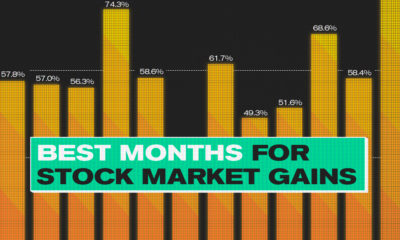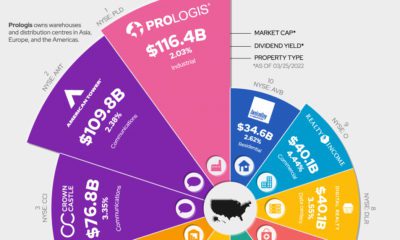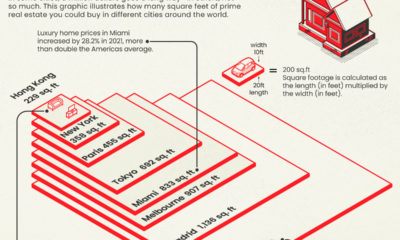With this week marking his 89th birthday, we thought it was a good time to highlight the 25 best Warren Buffett quotes accumulated through his lengthy and prestigious career.
The Warren Buffett Series
Part 5: Wisdom from the Oracle
Today’s infographic highlights the smartest and most insightful quotes from Buffett on investing, business, and life. It’s the fifth and final part of the Warren Buffett Series, which we’ve done in partnership with finder.com, a personal finance site that helps people make better decisions – whether they want to find the right credit card or become the next big value investor. Get infographics every day by subscribing to our free mailing list. After sifting through hundreds of quotes from the Oracle of Omaha, we’ve chosen the best 25 of them and sorted them into a few select categories:
Keeping it Simple
Buffett is known for putting his money in “no-brainer” businesses (i.e. Coca-Cola) that are simple to run, with long-term competitive advantages.
Temperament
For Buffett, how someone responds to different situations is far more important than their actual skills or knowledge level. Investors must not care what the crowd thinks, and they must be patient, focused, and decisive to maximize their potential.
Value
Buffett’s decision-making is driven by an assessment of value. Is the asset he is buying worth way more than it is currently being priced at by the fickle Mr. Market – if so, he’ll lay down his chips.
Conduct
A Midwestern gentleman, Buffett follows a simple and friendly style of business conduct, with deals often bounded by one’s promise or a simple handshake.
Perspective
At 89 years old, Buffett knows a thing or two about business and life. As a result, he’s developed some unique perspectives.
Life and Success
How did he build such a successful career, and how does one man generate so much wisdom? With $89.5 billion to his name, Warren Buffett is not only known for his self-made wealth and investing acumen, but also his wit and quotability. We hope this selection of the best Warren Buffett quotes helps you think about life and investing differently, and that the legendary investor continues to share his wisdom with the world.
Want more Buffett?
Don’t forget to check out the other parts of our Buffett infographic series:
Part 1: The Remarkable Early Years of Warren Buffett Part 2: Inside Warren Buffett’s Brain Part 3: The Warren Buffett Empire in One Giant Chart Part 4: Warren Buffett’s Wins & Fails
on Last year, stock and bond returns tumbled after the Federal Reserve hiked interest rates at the fastest speed in 40 years. It was the first time in decades that both asset classes posted negative annual investment returns in tandem. Over four decades, this has happened 2.4% of the time across any 12-month rolling period. To look at how various stock and bond asset allocations have performed over history—and their broader correlations—the above graphic charts their best, worst, and average returns, using data from Vanguard.
How Has Asset Allocation Impacted Returns?
Based on data between 1926 and 2019, the table below looks at the spectrum of market returns of different asset allocations:
We can see that a portfolio made entirely of stocks returned 10.3% on average, the highest across all asset allocations. Of course, this came with wider return variance, hitting an annual low of -43% and a high of 54%.
A traditional 60/40 portfolio—which has lost its luster in recent years as low interest rates have led to lower bond returns—saw an average historical return of 8.8%. As interest rates have climbed in recent years, this may widen its appeal once again as bond returns may rise.
Meanwhile, a 100% bond portfolio averaged 5.3% in annual returns over the period. Bonds typically serve as a hedge against portfolio losses thanks to their typically negative historical correlation to stocks.
A Closer Look at Historical Correlations
To understand how 2022 was an outlier in terms of asset correlations we can look at the graphic below:
The last time stocks and bonds moved together in a negative direction was in 1969. At the time, inflation was accelerating and the Fed was hiking interest rates to cool rising costs. In fact, historically, when inflation surges, stocks and bonds have often moved in similar directions. Underscoring this divergence is real interest rate volatility. When real interest rates are a driving force in the market, as we have seen in the last year, it hurts both stock and bond returns. This is because higher interest rates can reduce the future cash flows of these investments. Adding another layer is the level of risk appetite among investors. When the economic outlook is uncertain and interest rate volatility is high, investors are more likely to take risk off their portfolios and demand higher returns for taking on higher risk. This can push down equity and bond prices. On the other hand, if the economic outlook is positive, investors may be willing to take on more risk, in turn potentially boosting equity prices.
Current Investment Returns in Context
Today, financial markets are seeing sharp swings as the ripple effects of higher interest rates are sinking in. For investors, historical data provides insight on long-term asset allocation trends. Over the last century, cycles of high interest rates have come and gone. Both equity and bond investment returns have been resilient for investors who stay the course.



















